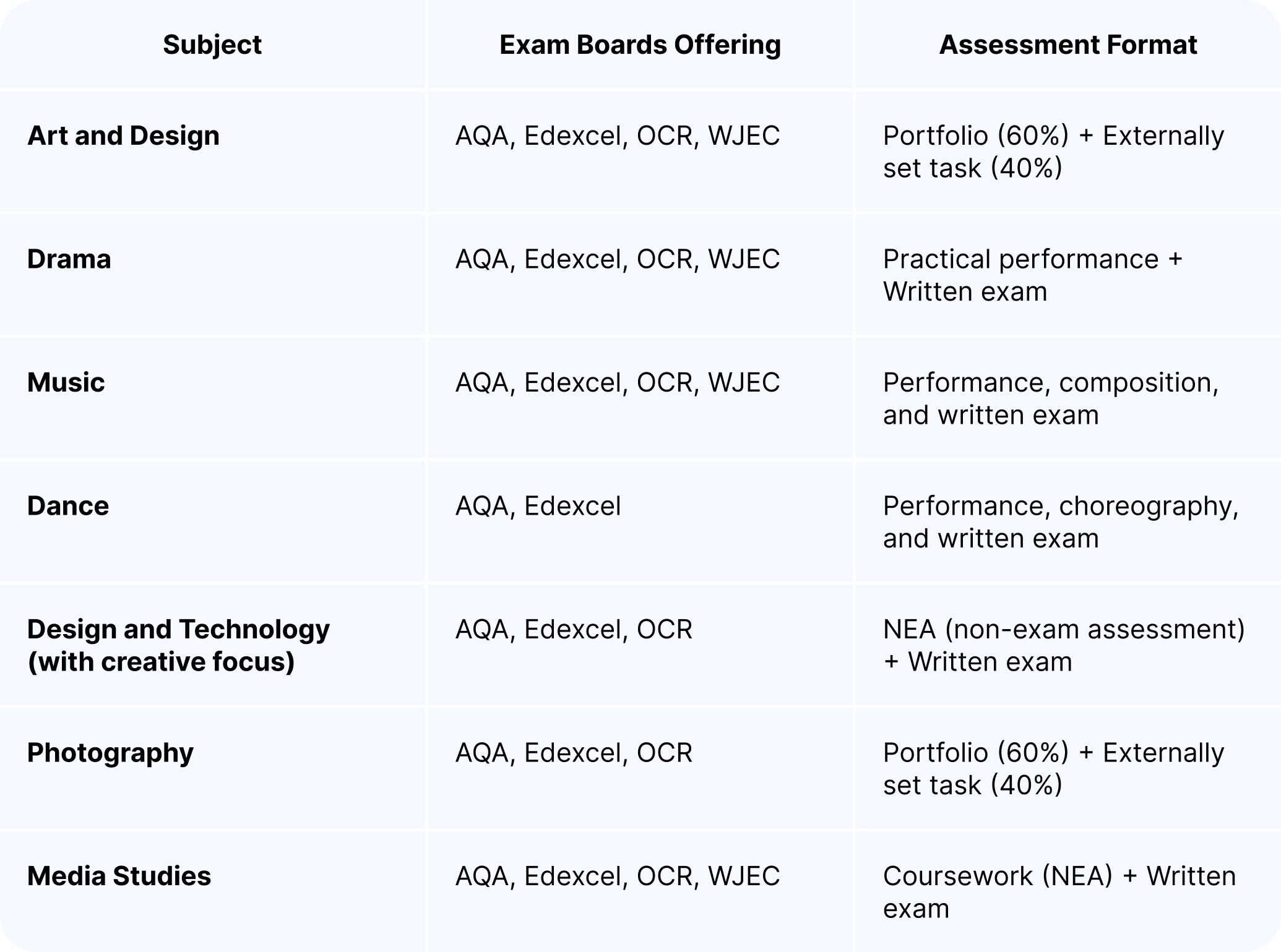Contents
Choosing GCSE Art, Drama, Music, and Creative Subjects is an exciting opportunity for students to explore creativity, develop new skills, and express ideas uniquely.
From Fine Art to Media Studies, these subjects encourage imagination while building transferable skills for further study and careers.
This guide covers:
The range of GCSE Art, Drama, Music and creative subjects available
Why these subjects matter for GCSE success
Exam boards and specifications overview
Topics and learning objectives for each subject
Revision and exam preparation tips
Sample questions to help with preparation
Why Art, Drama, Music and creative subjects matter for GCSE success
These subjects develop more than just creative skills. They encourage critical thinking, problem-solving, and resilience, all vital for academic success and beyond.
Studying creative GCSEs can also help:
Build confidence in self-expression
Improve communication skills
Foster cultural awareness and empathy
Offer a balance to more theoretical subjects
In addition, strong results in GCSE Art, Drama, Music and creative subjects can support applications to sixth form, college, or creative apprenticeships. While the only required GCSEs are English, Mathematics, and Science, schools must offer at least one arts subject. This can include Art, Music, Drama, or Media Studies.
Some schools encourage or even require students to choose one arts subject, though this depends on school policy.
Exam boards and specification overview
Here is a summary of the main GCSE subjects: Art, Drama, Music, and creative subjects. The information includes their exam boards and the methods used to assess them.

Topics and learning objectives for each subject
Art and Design
Topics may include: drawing, painting, sculpture, printmaking, digital art, textiles, and mixed media.
Learning objectives:
Develop practical skills using a variety of media and techniques
Explore visual language and personal ideas
Research artists and contextual influences
Drama
Topics may include: acting techniques, stagecraft, improvisation, play analysis, and theatre history.
Learning objectives:
Perform scripted and devised pieces
Analyse and evaluate live theatre
Apply dramatic conventions to communicate meaning
Music
Topics may include: performing, composing, music theory, set works, and listening skills.
Learning objectives:
Perform solo and ensemble pieces confidently
Compose original music to set briefs
Understand and analyse music from different genres and cultures
Dance
Topics may include: performance, choreography, and appreciation of professional works.
Learning objectives:
Develop technical and expressive dance skills
Create original choreography in response to a brief
Critically analyse professional dance works
Design and Technology (creative pathways)
Topics may include: product design, textiles, graphics, and resistant materials.
Learning objectives
Research, design, and create functional and aesthetic products
Apply creative problem-solving to design briefs
Understand materials, processes, and sustainability in design
Photography
Topics may include: camera techniques, composition, editing, and thematic projects.
Learning objectives:
Use photography techniques and digital editing tools effectively
Communicate ideas visually
Research and reference photographers and movements
Media Studies
Topics may include: media language, audience, representation, and industry.
Learning objectives:
Analyse media products across formats (film, print, digital)
Create media products to a professional brief
Understand how media impacts society and culture
Tips for revision and exam preparation
Revising for the arts is different from subjects that focus mainly on facts and formulas. Success comes from regular practice, creativity, and reflection.
Here are some simple, practical ways to prepare for each subject:
Art and Design
Keep a sketchbook: A visual diary of drawings, notes, and photos shows how ideas develop over time.
Try different techniques: Experiment with paint, print, digital, or sculpture, this makes work more varied and confident.
Plan ahead: Break large projects into small steps so coursework feels manageable.
Link to artists: Write about how the work of others has influenced your own, this strengthens final marks.
Drama
Rehearse little and often: Short, frequent practice helps build confidence on stage.
Watch yourself perform: Recording rehearsals makes it easier to spot what works well and what can be improved.
Get comfortable with key terms: Learning drama vocabulary helps with written answers and reflection.
Practise exam questions: Write about plays and performances to prepare for the written paper.
Music
Play every day: Even 10 minutes of practice improves fluency and stage confidence.
Listen carefully: When studying set works, make notes on rhythm, melody, and instruments as you go.
Build compositions step by step: Start with short musical ideas and develop them gradually.
Use listening papers: These sharpen your ear and prepare you for the exam.
Dance
Practise regularly: Repetition builds muscle memory and makes performance feel natural.
Review recordings: Watching back choreography helps spot details to improve.
Study professional works: Notice costumes, lighting, and movement to strengthen written answers.
Know the language: Learning dance terminology makes written questions easier.
Design and Technology (creative focus)
Work step by step: Start with research, then sketch designs, build prototypes, and refine.
Connect theory to practice: Use classroom learning in your coursework to show depth.
Learn from examples: Look at well-known designers or movements to inspire ideas.
Explain your choices: In the exam, be clear about why you picked certain materials or designs.
Tip: Many GCSE Art, Drama, Music, and creative subjects have coursework or portfolio parts. These can count for a large part of the final grade. Staying organised throughout the year will help.
Sample questions
(Note: These examples are adapted from past papers and specimen materials. Mark allocations and wording may differ slightly between exam boards. Students should check their own exam board specification.)
Art and Design – AQA:
Choose one artist whose work has influenced the portfolio. Explain how their style informed the final pieces. (8 marks – AO1: research and contextual understanding)
Drama – Edexcel:
Analyse how lighting and set design can enhance the mood of a scene in a live performance studied. (12 marks – AO3: analysing and evaluating live theatre)
Music – OCR:
Compare the use of melody in two set works from different genres. (8 marks – AO4: analysis and contextual understanding)
Dance – AQA:
Describe the choreographic intention behind a professional work studied. (6 marks – AO3: critical appreciation of professional works)
Design and Technology – Edexcel:
Explain how a final design meets the needs of the intended user. (10 marks – AO4: evaluate)
Photography – AQA:
Evaluate the use of composition and lighting in one portfolio piece. (8 marks – AO3: critical understanding)
Media Studies – OCR:
Analyse how gender is represented in a chosen television advertisement. (12 marks – AO1/AO2: analysis of representation and application of theory)
Bringing creativity into GCSE success
GCSE Art, Drama, Music and creative subjects offer a rewarding balance of creativity and academic challenge. Whether a student’s strengths lie in visual, performance, or media arts, there is an option to match their interests and future aspirations.
With consistent preparation, a clear understanding of assessment requirements, and encouragement from teachers and parents, these subjects can become a highlight of the GCSE years. Choosing a creative GCSE is more than a timetable decision; it’s an investment in skills, confidence, and future possibilities.
Don’t miss Atom’s GCSE giveaway!

Six months. Six epic prizes. Six chances to make the GCSE season unforgettable.
We’re launching Atom for GCSE prep in 2026, and to celebrate, over the next six months, we’re giving away thousands of pounds worth of prizes to help your child level up their GCSE revision.
Here’s a taste of what’s up for grabs:
The latest Apple tech, including an iPad Air, Vision Pro and more
Festival tickets for Boardmasters and Reading 2026
Europe interrail passes and £1,000 spending money
…and that’s just a few of the amazing prizes available.
Our first two winners have already taken home incredible prizes! Find out who they are and what they won in our latest giveaway update and keep an eye out for news of our November winner.
It’s free to join. UK only. Full T&Cs apply.
Contents
